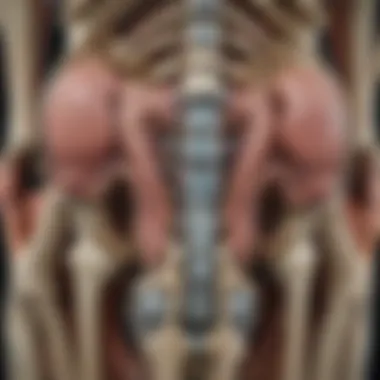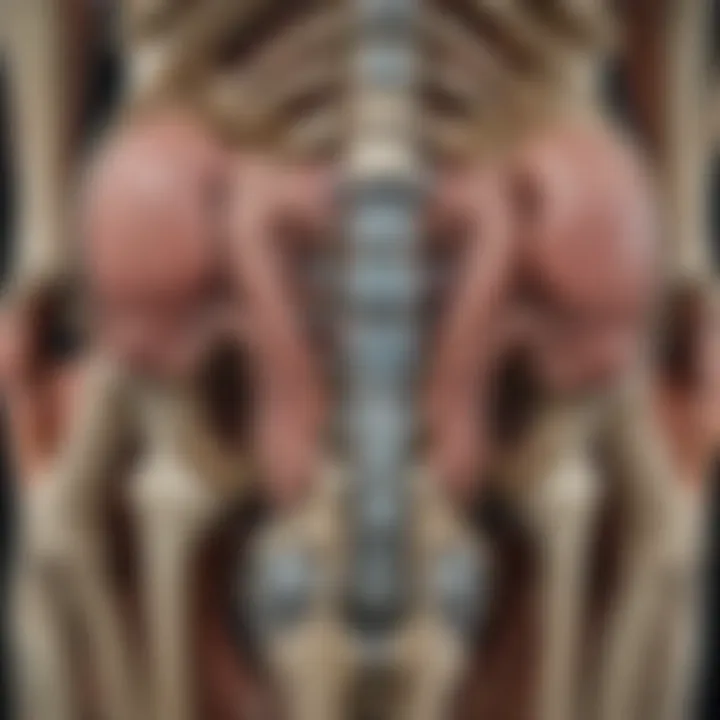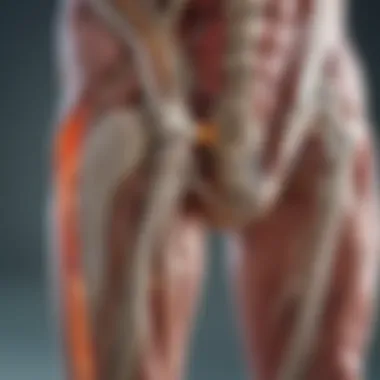Understanding Extremity MRI in Modern Medicine


Intro
Magnetic Resonance Imaging (MRI) has transformed the way we diagnose and treat musculoskeletal disorders. As the technology evolves, extremity MRI has become an essential tool in modern medicine, particularly in assessing conditions that affect the arms, legs, hands, and feet. This section will outline a research overview, focusing on the significance and methodology of the findings in this area.
Research Overview
Summary of Key Findings
A deeper understanding of extremity MRI shows that it significantly enhances diagnostic accuracy. The ability of MRI to create high-contrast images of soft tissues allows clinicians to differentiate between various tissues and pathologies. Key findings indicate that extremity MRI can accurately identify tears, joint abnormalities, and inflammatory conditions. Furthermore, studies suggest that advanced imaging techniques, including functional MRI and diffusion-weighted imaging, present new opportunities in evaluating complex cases.
Importance of the Research
The research in extremity MRI contributes greatly to various fields, such as orthopedics, rheumatology, and sports medicine. Accurate imaging leads to better-informed decisions regarding treatment. For instance, understanding the precise location and nature of a cartilage defect can help in choosing between surgical and non-surgical interventions. Additionally, more effective imaging can reduce unnecessary procedures, thereby minimizing risks and costs associated with over-treatment.
Methodology
Study Design
The studies reviewed typically employ a cross-sectional design. They evaluate patients presenting with musculoskeletal complaints, focusing on the correlation between MRI findings and clinical diagnoses.
Data Collection Techniques
Data is gathered through a combination of patient interviews, MRI scans, and follow-up clinical assessments. This multimodal approach ensures comprehensive evaluation. The integration of this data is crucial for developing a nuanced understanding of extremity-related musculoskeletal disorders.
"Extremity MRI serves as a bridge between clinical symptoms and precise anatomical diagnosis, significantly impacting patient care and treatment outcomes."
This research underscores the pivotal role of extremity MRI in modern medical practice, highlighting its potential to improve healthcare delivery. As technology continues to advance, ongoing studies will likely reveal even more applications and efficiency in using MRI for diagnosing extremity conditions.
Intro to Extremity MRI
The realm of medical imaging has evolved significantly, and Magnetic Resonance Imaging (MRI) stands at the forefront, particularly when it comes to examining the extremities. This section discusses the relevance and high importance of understanding extremity MRI in modern medicine. Today, we rely on MRI for its exceptional ability to visualize soft tissues, cartilage, ligaments, and other structures in the body, making it invaluable for diagnosing various musculoskeletal conditions.
The Benefits of Extremity MRI
Extremity MRI offers numerous advantages over other imaging modalities. Firstly, it provides high-resolution images without exposing patients to harmful ionizing radiation. This fact alone makes it preferable for repeated assessments, especially in younger patients. Additionally, the ability to obtain multi-planar images allows for a comprehensive view of complex anatomical structures, enhancing diagnostic accuracy and treatment planning.
Moreover, extremity MRI plays a vital role in identifying conditions that may not be apparent through traditional X-rays. For example:
- Tendon injuries: MRI can make subtle tears visible.
- Ligamentous injuries: MRI identifies damage to ligaments that is often missed with other techniques.
- Tumor detection: It aids in diagnosing benign and malignant tumors.
Considerations About Extremity MRI
While the benefits are substantial, several considerations must be taken into account. The cost and availability of MRI are significant factors. In some regions, access to MRI machines can be limited, creating delays in diagnosis and treatment. Furthermore, not all patients are suitable candidates for MRI. Those with certain implants or conditions may face contraindications.
Ultimately, understanding extremity MRI is crucial for healthcare professionals involved in diagnosing and treating musculoskeletal issues. The insights gained through this imaging modality can significantly impact patient outcomes. As technology continues to advance, the implications of extremity MRI will further intertwine with clinical practices, setting a new standard for care.
What is MRI?
Magnetic Resonance Imaging (MRI) is a non-invasive imaging technique that uses powerful magnets and radio waves to create detailed images of organs and tissues inside the body. Unlike X-rays, which use ionizing radiation, MRI does not carry the same risk of exposure. Its ability to capture images in multiple planes, along with the lack of radiation, particularly benefits patients requiring frequent imaging.
Specifics of Extremity MRI
Extremity MRI focuses on imaging the upper and lower limbs, including bones, muscles, cartilage, and connective tissues. When compared to a standard MRI, extremity MRI employs a modified approach, with specialized coils designed to optimize the signal from the limbs. The lower magnetic field strength can lead to faster imaging times and enhanced patient comfort, making it a preferred modality for outpatient settings.
In practice, extremity MRI can be conducted in an open or closed MRI machine. Each setting has its advantages, particularly in terms of patient anxiety management and equipment accessibility.
The understanding of extremity MRI encompasses not just the basics of the technology but also its role in patient care and management of musculoskeletal disorders. The ability to accurately diagnose and monitor conditions results in more effective treatment plans and improved patient outcomes.
MRI is a powerful tool in modern medicine that transcends traditional imaging, with significant implications for patient health and medical research.
The Anatomy of Extremities
Understanding the anatomy of extremities is vital in extremity MRI. Knowledge of this anatomy helps radiologists and clinicians accurately diagnose conditions. The extremities consist of the upper and lower limbs, each having distinct structures. This section will detail these anatomy parts and emphasize their relevance in MRI assessments.
Upper Extremity Anatomy
The upper extremity includes the shoulder, arm, forearm, wrist, and hand. Each segment plays a significant role in mobility and functionality.
- Shoulder: The shoulder joint connects the arm to the torso. Composed of the humerus, scapula, and clavicle, it provides a wide range of motion. In MRI, the rotator cuff's health is a common focus, as injuries in this area are prevalent.
- Arm: This part contains the humerus, which connects the shoulder to the elbow. Bone fractures here are relatively common and can be effectively diagnosed with MRI.
- Forearm: Comprised of the radius and ulna, the forearm allows for forearm rotation and grip. Conditions like tendonitis often require MRI for proper evaluation.
- Wrist and Hand: The wrist supports hand functions, comprising multiple carpal bones, while the hand includes metacarpals and phalanges. Pathologies such as ligament tears often necessitate detailed imaging here.


MRI plays a crucial role in visualizing soft tissues, bone marrow, and cartilage. This imaging technique can detect conditions like tears, fractures, and tumors, which are not always visible in X-rays. Therefore, understanding upper extremity anatomy enhances the quality of care provided.
Lower Extremity Anatomy
The lower extremity comprises the hip, thigh, knee, leg, ankle, and foot. This anatomy must be well understood for effective extremity MRI interpretation.
- Hip: The hip joint connects the lower limb to the pelvis. The stability offered by the hip joint is fundamental for weight-bearing activities. MRI can show labral tears or degenerative changes here.
- Thigh: The femur is the primary bone in this segment. Understanding its structure is important since many injuries occur in this area during sports activities. MRI can visualize both soft tissue and cortical bone changes in the thigh.
- Knee: A complex joint involving bones, muscles, and cartilages, the knee is a common site for injuries and degenerative diseases. MRI is frequently used to assess meniscal and ligament tears.
- Leg: The calf comprises the tibia and fibula. MRI can help in diagnosing stress fractures, which are common in athletes.
- Ankle and Foot: These areas consist of numerous small bones, allowing for great flexibility. Injuries or diseases here may involve tendons or ligaments, which MRI can effectively evaluate.
Both upper and lower extremity anatomy is crucial for accurate diagnosis through MRI. A thorough understanding will translate into better patient outcomes and targeted treatment approaches.
Technical Aspects of Extremity MRI
Understanding the technical aspects of extremity MRI is essential for optimizing diagnostic capabilities and enhancing patient care. This section delves into the various components of MRI machines, the protocols used for imaging, and the role of contrast agents in extremity MRI. Each of these elements plays a critical role in achieving high-quality imaging and accurate diagnosis in musculoskeletal conditions.
MRI Machine Components
An MRI machine consists of several key components that work together to produce detailed images of the extremities. These components include:
- Magnet: The primary component, providing the powerful magnetic field necessary for imaging. Most clinical MRI machines use superconducting magnets, which produce a stable and strong magnetic field.
- Gradient Coils: These coils are responsible for creating varying magnetic fields, allowing for spatial localization of the imaging signals.
- Radiofrequency Coils: These are used to transmit radio waves to the body and receive the signals emitted in return. Specially tailored coils for extremities can provide enhanced resolution for specific areas.
- Computer System: This processes the data collected and reconstructs it into the images that clinicians interpret.
The design of the MRI machine, especially those tailored for extremities, allows for easier patient positioning and comfort. This is particularly important since the extremities can be scanned while the patient remains comfortably seated or lying down, which may mitigate anxiety during the procedure.
Imaging Protocols
Imaging protocols dictate the specific settings and procedures followed during an extremity MRI. These protocols are crucial for obtaining high-quality images while ensuring patient safety. Significant factors that influence imaging protocols include:
- Patient History and Clinical Indications: The specific condition being evaluated will influence the selection of sequences and parameters.
- Sequence Selection: Common sequences used in extremity MRI include T1-weighted, T2-weighted, and STIR (Short Tau Inversion Recovery) sequences. Each brings out different tissue characteristics and abnormalities.
- Scanning Time: Protocols can be adjusted to balance the need for detailed imaging against the total time the patient spends in the machine. Time-efficient protocols can be particularly beneficial in busy clinical settings.
Developing MRI protocols tailored to the extremity being scanned can significantly increase diagnostic accuracy while also considering individual patient needs.
Contrast Agents in Extremity MRI
Contrast agents play a vital role in enhancing the visibility of specific structures and pathologies in extremity MRI. While not always necessary, they are particularly useful in certain clinical scenarios. The primary contrast agent used is gadolinium-based compounds. These agents present several considerations:
- Indications for Use: Contrast is often used in cases involving tumors, infection, or inflammatory conditions to improve the delineation of lesions against the surrounding tissues.
- Risks and Benefits: While generally considered safe, the use of contrast agents carries potential risks, such as allergic reactions or nephrogenic systemic fibrosis in patients with severe kidney dysfunction.
- Administration: The timing of contrast administration can vary; it can be given before or during the MRI, depending on the specific imaging protocol and clinical question.
Careful consideration of these factors ensures that the use of contrast agents maximizes diagnostic benefit while minimizing potential risks.
"Technical understanding of MRI machine components, imaging protocols, and contrast agents is essential for optimal patient diagnosis and care."
In summary, the technical aspects of extremity MRI form the backbone of effective diagnosis and patient management. Through careful integration of machine components, tailored imaging protocols, and judicious use of contrast agents, medical professionals can achieve a more nuanced understanding of musculoskeletal pathologies.
Clinical Applications of Extremity MRI
The clinical applications of extremity MRI are extensive and vital in modern medicine. This imaging modality plays a critical role in diagnosing diverse musculoskeletal ailments. The ability to visualize soft tissue structures, ligaments, tendons, and other components of the musculoskeletal system with high precision makes extremity MRI indispensable for clinicians. Moreover, the non-invasive nature of MRI allows for detailed anatomical assessments without exposing patients to ionizing radiation, making it a preferred choice in many medical situations.
Trauma and Injury Assessment
In cases of trauma, MRI is essential for comprehensively evaluating injuries. When a patient presents with acute pain or restricted movement after an accident, MRI can aid in determining the extent of damage. For example, joint injuries, such as tears in the anterior cruciate ligament (ACL) or meniscal tears in the knee, are easily diagnosed through extremity MRI.
MRI’s capability to depict bone marrow edema is particularly beneficial. This feature can indicate contusions or fractures that may not appear on traditional X-rays initially. Furthermore, early detection of these conditions is crucial for improving treatment outcomes and preventing long-term complications.
Degenerative Diseases
Degenerative diseases, such as osteoarthritis and tendinopathy, also benefit from MRI’s diagnostic capabilities. The high-resolution images provided by extremity MRI allow for the assessment of cartilage wear and changes in soft tissue structure over time.
By using MRI, healthcare providers can monitor disease progression and evaluate treatment efficacy. Another important aspect is that it can visualize subtler changes that might not be detectable with other imaging modalities. This rich detail aids in tailoring treatment plans for patients, which can involve physical therapy, medications, or surgical options when necessary.
Tumor Detection and Evaluation
Extremity MRI is crucial in the detection and evaluation of tumors within the limb regions. It provides a non-invasive method to assess both benign and malignant masses, guiding the clinical management of patients. Radiologists can analyze the characteristics of the tumors, including their size, margins, and relationship to surrounding structures.
In cases where a biopsy is required, MRI can aid in accurately targeting the area of concern. Post-treatment, MRI plays a significant role in monitoring recurrence, allowing for timely interventions if needed.
"The effectiveness of extremity MRI in tumor detection directly influences treatment options and overall patient outcomes."
In summary, the clinical applications of extremity MRI encompass a broad range of conditions, from trauma to degenerative diseases and tumor evaluations. By utilizing this imaging technique, healthcare professionals can make informed decisions based on robust, non-invasive data, ultimately improving patient care.


Advanced Imaging Techniques
Advanced imaging techniques in extremity MRI are essential for enhancing diagnostic accuracy and treatment planning. They build upon conventional MRI, providing a more detailed understanding of musculoskeletal disorders. Two prominent methods include Functional MRI and Diffusion-weighted Imaging, each offering unique insights into tissue behavior and pathology.
Functional MRI in Extremities
Functional MRI (fMRI) focuses on brain activity but has also found its place in extremity diagnostics. By measuring changes in blood flow associated with neural activity, fMRI enables the evaluation of muscle function and response to physiological stimuli. In extremities, this technique can be adapted to explore muscle dynamics during specific actions or exercises.
The detailed maps generated by fMRI can highlight muscle coordination and potential dysfunctions. This is particularly beneficial in rehabilitative settings, where understanding muscle interaction informs treatment approaches.
"Functional MRI provides a window into muscle performance that traditional methods may overlook."
Furthermore, fMRI aids in assessing recovery post-injury, allowing clinicians to tailor rehabilitation protocols based on objective data. The integration of fMRI into routine extremity assessments could revolutionize how practitioners approach recovery and strength training agendas.
Diffusion-weighted Imaging
Diffusion-weighted Imaging (DWI) is another innovative technique employed in extremity MRI. It measures the diffusion of water molecules within tissues, providing insights into cellular integrity and microstructural changes. In patients with musculoskeletal disorders, DWI can reveal vital information about the pathology of tissues like cartilage, muscles, and ligaments.
The advantage of DWI lies in its ability to detect early changes that may not be visible with conventional MRI. For example, cartilage degeneration or inflammation can be pinpointed at stages where treatment may still be effective, preventing further complications.
Moreover, DWI may assist in distinguishing between benign and malignant lesions, enhancing tumor characterization. Such precision in imaging supports clinicians in making more informed decisions regarding treatment pathways.
In essence, advanced imaging techniques like Functional MRI and Diffusion-weighted Imaging represent significant progress in extremity MRI. They not only improve diagnostic accuracy but also play a crucial role in the ongoing management of musculoskeletal disorders.
Interpretation of Extremity MRI Results
The interpretation of extremity MRI results is a vital component of modern diagnostic practices. Radiologists and other healthcare professionals must accurately analyze imaging to discern various pathologies of the musculoskeletal system. This section explores the critical elements of interpreting MRI results, emphasizing its benefits and considerations, which enhance clinical decision-making.
Identifying Pathologies
The capacity to identify pathologies through extremity MRI is fundamental. MRI provides high-resolution, detailed images of soft tissues, ligaments, muscles, and cartilage. This ability is crucial in diagnosing conditions such as fractures, tears, inflammatory diseases, and tumors.
Effective identification involves recognizing subtle changes in normal anatomy. Radiologists often compare the MRI findings with established anatomical landmarks, evaluated from previous imaging studies when available. Several elements come into play during this process:
- Patient History: Understanding the clinical history aids in correlating symptoms with imaging findings.
- Contrast Utilization: Use of contrast agents can enhance the visibility of certain abnormalities, improving diagnostic accuracy.
- Multiplanar Imaging: MRIs allow viewing from multiple planes, providing comprehensive insights into structural anomalies.
"An accurate diagnosis hinges on meticulous scrutiny of MRI images, considering both technical and biological factors."
Identifying pathologies accurately can guide the treatment plan effectively and avoid unnecessary interventions. Moreover, with advanced techniques like diffusion-weighted imaging and functional MRI, subtle differences in tissue composition can be evaluated, further augmenting the identification of distinct pathologies.
Reporting and Documenting Findings
Once pathologies are identified, the next step involves reporting and documenting findings. This is a specialized skill that combines clinical knowledge with precise language. The report serves as a communication tool, conveying critical insights to other healthcare providers.
Key aspects of reporting include:
- Clarity: Use clear language to describe findings. Medical jargon should be minimized where possible for better understanding.
- Structure: Typically follows standard practices, often including clinical history, imaging technique, observations, and impression.
- Objective Interpretation: Be factual and unbiased, basing conclusions strictly on imaging findings.
Documentation must also adhere to established guidelines to maintain consistency and accuracy. A well-documented MRI report often includes:
- Findings Summary: Key observations should be succinctly outlined. Each abnormality described should correlate with the preceding clinical history.
- Recommendations for Further Imaging: If necessary, suggest additional imaging techniques or follow-up studies.
- Actionable Insights: Provide guidance on potential management strategies based on your findings.
Accurate reporting ensures all concerned parties understand the diagnostic results, which can influence treatment pathways and patient outcomes significantly. In the context of patient care, seamless communication among multidisciplinary teams is paramount in optimizing therapeutic strategies.
The Role of the Radiologist
The role of the radiologist in extremity MRI is critical. Radiologists are specialized medical doctors trained to interpret medical images, including those generated by MRI. Their expertise significantly enhances the capacity to detect conditions affecting the extremities, such as fractures, tears, and degenerative diseases. As imaging techniques continue to evolve, the importance of radiologists becomes more pronounced in ensuring accurate diagnoses.
Radiologic Expertise
Radiologic expertise encompasses a broad range of knowledge and skills. Radiologists must understand the physics of MRI technology, including how varying settings influence image quality. They also need to be well-versed in normal anatomy and the variety of potential abnormalities that can appear on scans. Knowledge of specific imaging protocols enhances their ability to tailor the MRI examination according to a patient's unique clinical needs. Additionally, the interpretation process is not merely about recognizing pathology; it often requires correlating findings with clinical symptoms and other imaging modalities.
This expertise allows radiologists to provide comprehensive assessments, which is crucial for effective patient management. They analyze images in detail, identifying subtle changes that may indicate early-stage diseases. As a result, their evaluations can guide treatment plans and influence outcomes positively.
Collaboration with Clinicians
Collaboration between radiologists and clinicians is fundamental to optimizing patient care. Effective communication ensures that radiologists understand the clinical context, which is essential for accurate imaging interpretation. Clinicians provide vital information regarding the patient's history, presenting symptoms, and other tests that may impact MRI interpretation.


This interdisciplinary relationship often leads to better diagnostics. When radiologists and clinicians work together, it is possible to establish a clearer connection between imaging results and therapeutic decisions. For example, a clinician might consult with a radiologist before deciding on the necessity of an MRI or may seek further clarification on ambiguous scan results. Such discussions enhance the overall quality of patient care, leading to more targeted therapies and efficient management of musculoskeletal conditions.
"Collaboration between radiologists and other healthcare professionals leads to improved patient outcomes and more efficient care delivery."
Through continuous collaboration, both parties can stay updated on the latest advancements in imaging technology and treatment options, further enhancing the capabilities of the healthcare team. The synergy between clinicians and radiologists not only augments the diagnostic process but also strengthens the healthcare system at large.
Patient Considerations and Comfort
Ensuring patient considerations and comfort during an extremity MRI is essential in modern medical practices. Patient experience can significantly affect the quality of the imaging process and ultimately influence diagnostic outcomes. A crucial aspect is addressing concerns before the procedure begins to enhance the overall experience and promote cooperation from the patient. Such efforts can lead to high-quality images, which are vital for accurate interpretations by radiologists and subsequent treatment plans by clinicians.
Preparing for an Extremity MRI
Preparation for an extremity MRI starts with understanding what the procedure entails. Patients should be made aware of the basic process, including how long the scan will take and what positions they will need to maintain. This knowledge can help demystify the experience. It's important for practitioners to explain the concept of magnetic resonance imaging itself. For example, patients may benefit from a simple explanation of how the MRI machine will capture detailed images of their extremities without exposing them to ionizing radiation.
Additionally, patients should receive guidance regarding attire and any items they need to remove before the scan. Comfortable clothing that is free from metal parts is often recommended. Items such as jewelry, watches, or even certain body piercings can create interference with the imaging process. Therefore, advising patients to leave valuables at home can also help foster a more relaxed atmosphere.
Moreover, discussing any special accommodations is also crucial. For instance, if a patient has a fear of enclosed spaces, open MRI machines can be considered. Preparing them for the environment, such as the sounds that the machine makes, can significantly help in reducing anxiety before the scan.
Managing Anxiety and Expectations
Anxiety management is a fundamental part of enhancing patient comfort during an extremity MRI. Patients often approach imaging procedures with unease. Hence, practitioners should take proactive steps to address any apprehension. One effective strategy involves providing a pre-scan consultation. During this time, addressing any questions or misconceptions about the MRI can alleviate fears.
Setting realistic expectations about the procedure is also beneficial. Many patients do not know how long the MRI will take or what sensations they might experience, such as the loud noises produced by the machine. Educating them in these matters can lead to a more calming experience.
In some instances, calming techniques may be employed to help manage anxiety. These may include deep breathing exercises as the procedure begins, or utilizing headphones to listen to calming music during the scan. Facilities might offer stress balls or other fidget toys to keep the patient's hands busy and provide a distraction during the imaging process.
Studies show that managing discomfort and anxiety before an MRI can result in improved cooperation, leading to better-quality images and more accurate diagnoses.
Future Perspectives in Extremity MRI
The domain of extremity MRI is evolving rapidly, emphasizing the need to explore future perspectives. The integration of emerging technologies and a focus on innovative research will potentially reshape the landscape of musculoskeletal imaging. Each advancement offers significant benefits, such as improved accuracy, enhanced patient comfort, and more efficient clinical workflows. These aspects are pivotal not just for diagnostic purposes but also for treatment planning and monitoring.
Emerging Technologies
Emerging technologies are fundamentally transforming MRI capabilities. One of these advancements is the development of ultra-high-field MRI systems. These systems utilize higher magnetic fields, enhancing image resolution and allowing clearer visualization of structures within the extremities. For example, a 7T MRI can provide superior contrast and detail compared to the traditional 1.5T or 3T MRI machines.
Other noteworthy technologies include:
- Artificial Intelligence (AI): AI algorithms are being incorporated into MRI image analysis. These tools assist radiologists by automating the detection of abnormalities and improving diagnostic accuracy. AI can also help in reducing the time taken to interpret results.
- Portable MRI Systems: The introduction of portable units increases accessibility, especially in remote areas or for patients with mobility challenges. These systems enable rapid diagnosis while minimizing the need for patient transport.
- Hybrid Imaging Techniques: Combining MRI with other modalities, like Positron Emission Tomography (PET), offers a multifaceted view of pathologies. This integration allows for both functional and anatomical assessment in one session.
Research Trends and Innovations
Research trends in extremity MRI are continuously uncovering new horizons. Clinical studies are focusing on the effectiveness of different imaging protocols and contrast agents.
"Continued research is essential to validate new techniques and to ensure these advancements benefit patient outcomes."
Key areas of research include:
- Optimizing Imaging Protocols: Researchers are investigating how varying imaging parameters affect diagnostic yield. Custom protocols may enhance the detection of subtle lesions that standard protocols might miss.
- Patient-Centric Innovations: Several studies are analyzing ways to make MRI more comfortable for patients. This includes shorter scan times and reduced noise levels, contributing to a more pleasant experience.
- Outcome Studies: As MRI technologies advance, there is a growing need to assess their impact on patient care and outcomes. Ongoing research aims to correlate MRI findings with treatment efficacy and overall patient recovery.
In summary, the future of extremity MRI looks promising with advancements in technology and ongoing research. These elements are not only improving clinical diagnostics but also paving the way for more sophisticated and holistic approaches to musculoskeletal health.
The End
The process of utilizing Extremity MRI in modern medicine is multifaceted and vital. This article's exploration of extremity MRI confirms its importance in diagnosing and treating musculoskeletal conditions. Through diverse sections analyzing technical aspects, clinical applications, and emerging trends, we highlight how this imaging technique shapes patient outcomes.
Summarizing Key Insights
A deeper understanding of extremity MRI involves several key insights:
- Technical Proficiency: The MRI machine's components and imaging protocols directly influence diagnosis accuracy.
- Clinical Relevance: From trauma assessment to degenerative diseases, extremity MRI proves its value across various medical scenarios.
- Collaborative Efforts: The role of radiologists in interpreting results fosters essential partnerships with clinicians, enhancing the quality of care.
- Patient-Centric Approach: Comfort and preparation for patients remain paramount, influencing their overall experience and outcomes.
These elements collectively emphasize how integrated and informed the use of extremity MRI is in healthcare.
The Impact of Extremity MRI on Healthcare
Extremity MRI holds substantial significance in healthcare for several reasons:
- Enhanced Diagnostic Accuracy: The capability to visualize internal structures non-invasively leads to more precise diagnosis.
- Informed Treatment Plans: Accurate imaging helps physicians create specific and effective treatment strategies tailored to individual patient needs.
- Reduced Need for Surgical Interventions: With enhanced imaging, many conditions can be diagnosed and treated without surgery, lowering patient risk and recovery time.
- Ongoing Research Dynamics: Continuous advancements, such as functional MRI and diffusion-weighted imaging, contribute to improving diagnostic capabilities further.
"The integration of Extremity MRI into patient care pathways illustrates a significant evolution in diagnostic medicine."
The above factors demonstrate the profound impacts of extremity MRI on improving outcomes and effectiveness in healthcare, thereby validating the relevance of ongoing research and development in this field.



